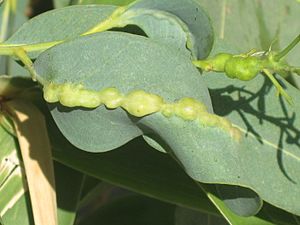Blue gum chalcid wasp facts for kids
Quick facts for kids Blue gum chalcid wasp |
|
|---|---|
 |
|
| Female Leptocybe invasa inserting ovipositor into the petiole of Eucalyptus tree | |
| Scientific classification | |
| Genus: |
Leptocybe
|
| Species: |
invasa
|
Leptocybe invasa, also known as the blue gum chalcid wasp or eucalyptus gall wasp, is a tiny insect. It's a type of chalcid wasp. This wasp creates strange bumps, called galls, on Eucalyptus trees. Scientists first described it in 2004. They found it causing problems on eucalyptus trees in the Middle East and Mediterranean. This wasp originally comes from Australia. Now, it has spread to many places where eucalyptus trees grow.
What it Looks Like
This wasp is very small. It's only a little over one millimeter long. That's about the size of a pinhead! Its body is mostly brown. It can look a bit shiny, with hints of blue or green. Some parts of its legs are yellowish.
Where it Lives
The blue gum chalcid wasp comes from Queensland, Australia. Scientists are still figuring out its exact home range there. However, it has become an invasive species in many other places.
It has spread to eucalyptus trees in parts of Africa, Asia, and Europe. You can find it as far north as the United Kingdom. It's also in the Pacific Region, southern South America, the Middle East, Mexico, and the United States. This wasp seems to be spreading more and more.
How it Was Discovered
Leptocybe invasa was first noticed in the year 2000. People saw that river red gum trees in the Middle East and Mediterranean were getting strange, bumpy growths. These bumps, called galls, were making the trees look bad. The damage became so serious that it hurt tree farms.
Scientists collected these galls. From them, a new type of chalcid wasp emerged. In 2004, this wasp was officially named Leptocybe invasa.
How it Lives
The female wasp lays tiny eggs in new leaf buds on eucalyptus trees. She makes a neat line of eggs. Sometimes, the tree's sap might cover the spot where the eggs are laid. If many wasps attack a tree, they can kill the new buds.
If a bud survives, it starts to form a corky layer. This happens about one to two weeks after the eggs are laid. This corky spot grows and becomes shiny. It changes color from green to pink, then to dark pink or red. Later, it loses its shine and turns dull brown or reddish.
The wasp larva grows inside this gall. When it becomes an adult wasp, it comes out of the gall. The galls are round and can be up to 2.7 millimeters wide. A single leaf might have 3 to 6 galls. But sometimes, up to 65 galls have been seen on one leaf!
Adult wasps come out of the galls after growing inside for 3 to 4 months. In cooler places, there might be 2 or 3 groups of new adults each year. But in tropical areas, there can be as many as 6 groups! Female wasps can reproduce without a male. This helps their population grow very quickly. They can live for up to 7 days.
Many types of eucalyptus trees can be affected by this wasp. Some common host trees include:
- Bangalay (Eucalyptus botryoides)
- Apple box (E. bridgesiana)
- Tasmanian blue gum (E. globulus)
- Cider gum (E. gunnii)
- Flooded gum (E. grandis)
- Swamp mahogany (E. robusta)
- Sydney blue gum (E. saligna)
- Forest red gum (E. tereticornis)
- Manna gum (E. viminalis)
Controlling the Wasp
Scientists are looking for ways to control Leptocybe invasa. One method is using biological control. This means using other living things to fight the pest.
Three types of tiny wasps, called parasitoids, have been found to attack Leptocybe invasa. These are Quadrastichus mendeli, Aprostocetus causalis, and Megastigmus viggianii. Quadrastichus mendeli grows quickly.
Another promising parasitoid is Selitrichodes neseri. This wasp was found in Australia in 2014. It only attacks Leptocybe invasa. Scientists believe it could be a good way to control the blue gum chalcid wasp.


